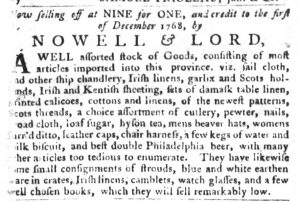What was advertised in a colonial American newspaper 250 years ago today?

“A WELL assorted stock of Goods, consisting of most articles imported into this province.”
In their advertisement in the January 19, 1768, edition of the South-Carolina Gazette and Country Journal, Nowell and Lord incorporated many of the most common marketing strategies deployed by merchants and shopkeepers in eighteenth-century America. The format of their advertisement, like the appeals, would have been familiar to readers. Like many of their competitors in Charleston and throughout the colonies, Nowell and Lord composed a list-style advertisement that revealed the range of goods they stocked, from “Irish and Kentish sheeting” to “leather caps” to “blue and white earthen ware.”
In and of itself, this format demonstrated the veracity of one of their appeals to potential customers: consumer choice. The partners reiterated that their patrons could choose the items that matched their needs, desires, tastes, and budgets throughout their advertisement. First, they described their inventory as “A WELL assorted stock of Goods,” proclaiming that it included “most articles imported into this province.” In other words, customers were unlikely to find merchandise in other shops that Nowell and Lord did not also carry. To underscore the variety they offered, the partners promoted their “choice assortment of cutlery” midway through the advertisement. They also made a point of noting that the list they printed in the newspaper was not exhaustive; instead, they also carried “many other articles too tedious to enumerate.” Customers would delight in the number of choices available to them when they visited Nowell and Lord’s shop.
In addition to consumer choice, the shopkeepers also made appeals to price and fashion. For instance, they stressed that they sold their merchandise “remarkably low.” To make their wares even more affordable, they offered “credit to the first of December 1768.” When it came to textiles for making garments, they informed readers that they imported “the newest patterns,” allowing customers to impress their friends and acquaintances by keeping up with current fashions in other parts of the empire.
Nowell and Lord deployed consumer choice as the central marketing strategy in their advertisement, but they supplemented that appeal with assurances about price and fashion. To sell their merchandise, they replicated methods used by countless other advertisers throughout the colonies. That so many merchants and shopkeepers consistently relied on the same strategies testifies to the power they believed those strategies possessed to entice and influence colonial consumers.
